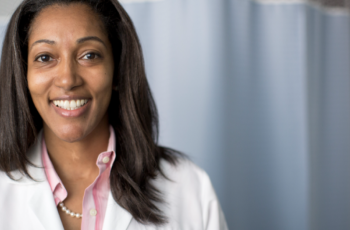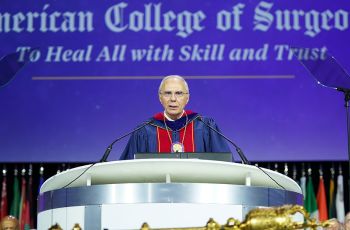October is Breast Cancer Awareness Month, and according to the National Breast Cancer Foundation, every two minutes a woman is diagnosed with breast cancer. When it’s caught early, before it’s had the chance to spread, however, the five-year survival rate for patients is 99%. Here, Rachel Brem, MD, vice chair of radiology and director of the George Washington University (GW) Medical Faculty Associates (MFA) Breast Imaging and Intervention Center, Christine Teal, MD, associate professor of surgery and director of the Breast Care Center at the GW MFA, and David Sousa Barreto, MD, breast imaging fellow at the GW MFA, discuss the basics of breast cancer, diagnosis, treatment, and ways to reduce one's risk.
Q. How common is breast cancer?
Brem, Teal, and Barreto: Breast cancer is the most common cancer among women in the United States (except for skin cancer). According to the American Cancer Society, 1 in 8 women will develop breast cancer, which means that an average lifetime risk of a woman in the United States developing breast cancer is about 13%. In the U.S. this year, an estimated 281,550 will get breast cancer, and 43,600 women will die from breast cancer. So far, breast cancer is the second leading cause of cancer death in women in 2021.
Over the past two decades, the death rate from breast cancer has decreased by more than 40% as a result of both improved screening and improved treatment. However, it is important for women to know that a mammogram may not be enough. For women with dense breast tissue, including more than 40% of those in the U.S., mammograms may not show all of the potential tumors. For them, mammograms are somewhat less effective, yet women with dense breast tissue are at substantially increased risk of breast cancer. They should also have an annual examination with breast ultrasound in addition to mammography to find these hidden cancers.
Q. At what age should people start getting screened for breast cancer?
Brem, Teal, and Barreto: Organizations differ on the recommendation for when women should start screening for breast cancer, which can often be confusing and contradictory. Delaying screening can be dangerous, as it can lead to increased mortality.
Starting at age 40, the incidence of breast cancer increases steadily with age. Delaying screening mammograms later than age 40 will result in more American women dying of breast cancer. Therefore, there is no reason to delay a screening mammogram, and every woman should begin screening at the age of 40 unless she has a family history of breast cancer. Women with a first-degree relative (mother, sister, or daughter) or two second-degree relatives should begin screening 5-10 years earlier than the age their family member was diagnosed. EARLY DETECTION SAVES LIVES! If a breast cancer is diagnosed in a very early stage with screening mammography, before it can even be felt as a lump, it is more likely to be curable.
You might ask, “Why don’t all organizations recommend screening mammography to begin at age 40 if it saves the most lives?” The answer is what some of the organizations describe as the “harms” of mammography. The greatest harm is the anxiety that a woman might feel if, after a screening mammogram, she is called back for additional imaging to clarify something that was seen. This does not mean you have breast cancer. Rather, it means additional imaging is needed, and most often the imaging clarifies what is seen. Sometimes a biopsy is needed. Today, a breast biopsy is much like going to the dentist. It is done with a needle instead of a knife, in about an hour, and without IV anesthesia or stitches. Women can often go back to work after their biopsies. Assuredly, having late-stage breast cancer is much more anxiety-producing than being called back for additional imaging to make sure you don’t have breast cancer.
Q. What are the symptoms of breast cancer?
Brem, Teal, and Barreto: Breast cancer can have many different symptoms or can even be absolutely without any symptoms. When symptoms are present, they may include one or more of the following: a lump or mass in the breast and/or in the armpit; breast skin changes (redness and thickening); discharge from the nipple (especially when bloody); changes in the usual nipple position/appearance (turning inward or changing direction); swelling of the breast; or even scaliness/ulcer on the nipple/breast.
While each woman has her own breast anatomy and shape, it is important to be familiar with your breasts so you know what your “normal pattern” feels and looks like. No one knows you as well as you know you. If you notice any changes in your breast(s), you should consult with your health care provider. However, many breast cancers are found during regular annual screening mammography.
Q. What are the risk factors for breast cancer?
Brem, Teal, and Barreto: By definition, a breast cancer risk factor is any trait or circumstance that increases the likelihood of a woman of developing breast cancer. In the U.S. being a woman is the number one risk factor for breast cancer. Having a first-degree relative being diagnosed with breast cancer is considered a high-risk factor.
Interestingly, more than 75% of women diagnosed with breast cancer have no family history of the disease. Women who had their mammogram and were identified as having a dense breast were 4-6 times more likely to be diagnosed with breast cancer when compared to women with a less dense breast. Therefore, additional screenings with other imaging modality should be considered.
Some genetic mutations are associated with an increased risk for breast cancer; the most important (and frequent) of which is the BRCA gene. When a patient has been biopsied for a breast abnormality and the result yielded some high-risk lesion (such as atypical breast cells), this can increase the likelihood of developing breast cancer in a lifetime by about 8-10 times. Other risk factors include increased age, being overweight, and a previous personal history of breast cancer or ovarian cancer. African American and Ashkenazi Jews are also at increased risk.
Some lifestyle habits can decrease the risk of having breast cancer, such as eating a balanced diet, maintaining a healthy weight, exercising regularly, avoiding smoking, and limiting alcohol consumption.
How does the MFA care for patients with breast cancer?
Brem, Teal, and Barreto: The MFA has a state-of-the-art, holistic, comprehensive program to care for women with breast issues and breast cancer. Our multi-disciplinary team includes a nurse navigator to help with any aspect of the journey; internationally known breast surgeons, radiologists, oncologists, pathologists, plastic surgeons, geneticists, complementary medicine with naturopathic doctors, and physical medicine, rehabilitation, and nutrition specialists.
We also have a magnificent Breast Center, which was designed to be a calming environment for all the women we see. In addition, we have a world-renowned, high-risk program for women at increased risk of breast cancer.
We are extremely proud of our multi-disciplinary approach. All of the women seen in our center are getting the latest technology with 3D mammography; breast ultrasounds, including automated whole-breast ultrasounds for women with dense breasts; MRIs; and a cutting-edge, minimally invasive breast biopsy program. Our radiologists are dedicated to only breast imaging. In addition, our surgeons and oncologists are internationally recognized, as are all the members of our team. We have been recognized as Best Doctors and Best Cancer Doctors by Newsweek, Dr. Oz, Castle Connolly, Who’s Who in American Medicine, and many other prestigious organizations.
To make an appointment with a breast care specialist, visit the GW MFA Comprehensive Breast Center or call 202-741-3270.



